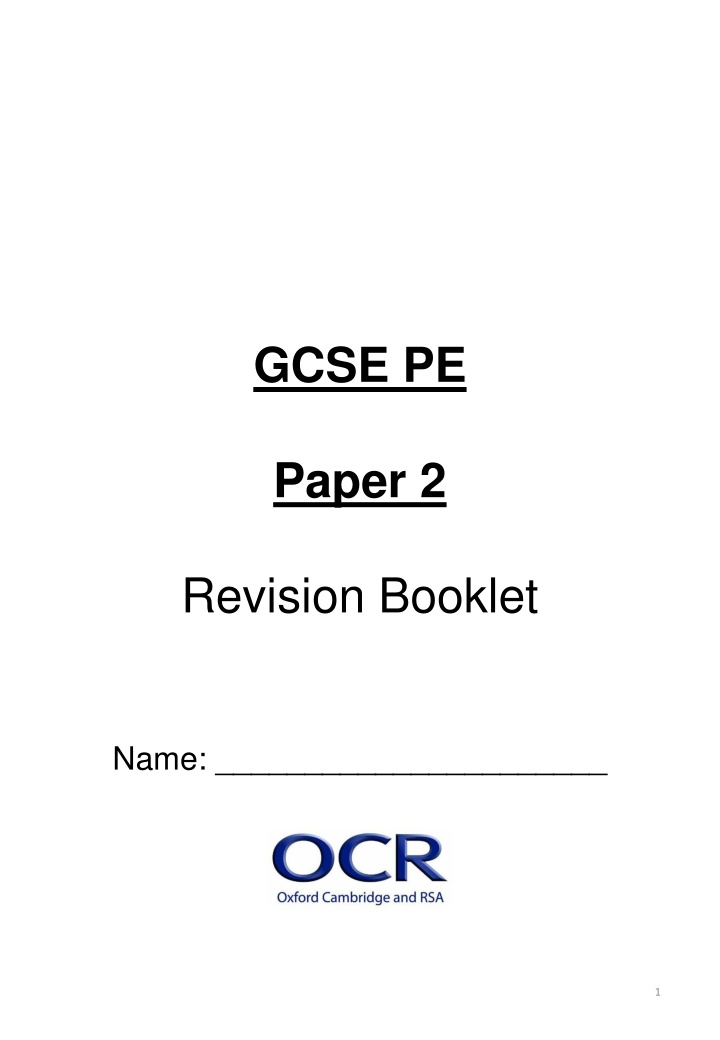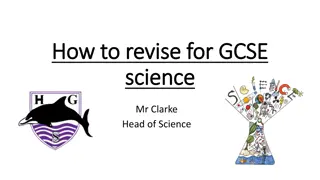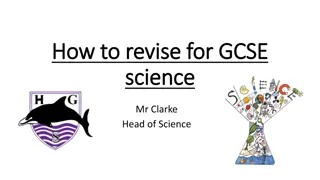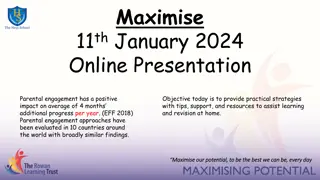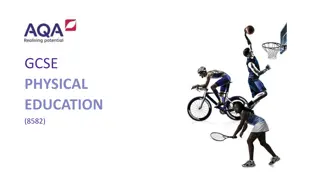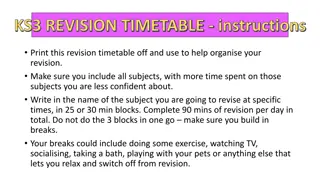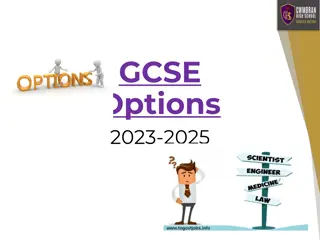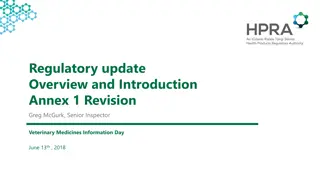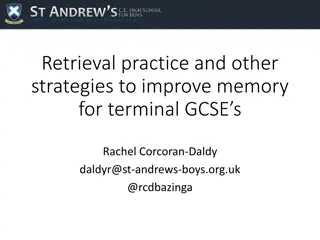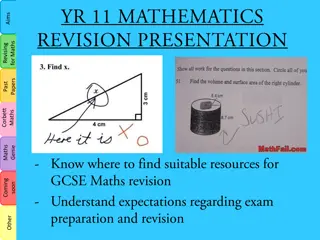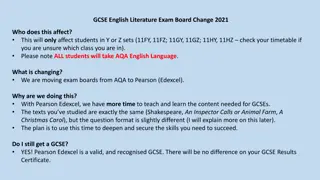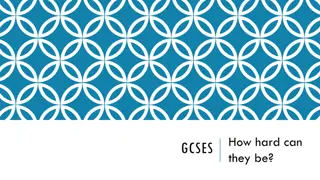GCSE Physical Education Revision Guide
This GCSE revision guide covers key topics in Physical Education, focusing on engagement patterns, factors influencing participation, strategies for promoting participation, and the impact of commercialisation on sport. It explores current trends in physical activity, considerations for different social groups, and ways to increase participation levels. The guide also delves into the benefits of commercialisation in sport, including sponsorships and media influence.
Download Presentation

Please find below an Image/Link to download the presentation.
The content on the website is provided AS IS for your information and personal use only. It may not be sold, licensed, or shared on other websites without obtaining consent from the author.If you encounter any issues during the download, it is possible that the publisher has removed the file from their server.
You are allowed to download the files provided on this website for personal or commercial use, subject to the condition that they are used lawfully. All files are the property of their respective owners.
The content on the website is provided AS IS for your information and personal use only. It may not be sold, licensed, or shared on other websites without obtaining consent from the author.
E N D
Presentation Transcript
GCSE PE Paper 2 Revision Booklet Name: ______________________ 1
GCSE Engagement Patterns: What do I need to know? Be familiar with current trends in physical activity and sport, understand how different factors affect participation, understand strategies that promote participation. Social Group How does this affect participation? Age Gender Ethnicity Religion/Culture Family Time/Work Commitments Cost/Disposable Income Disability Opportunity/ Access Discrimination Environment Media Coverage Role Models 2
GCSE Engagement Patterns: What do I need to know? Be familiar with current trends in physical activity and sport, understand how different factors affect participation, understand strategies that promote participation. The Scenario What has happened? The number of people participating in sport since 2012. The popularity of running since 2012 Are men or women more likely to take part in sport? What is the most popular team sport in the country? The popularity of disability sport since 2012 Strategy How can you increase participation? Promotion Provision Access 3
Unit 4.1 Test 1.Which one of the following could have a negative effect on participation in physical activities? a.Free swimming for children during school holidays b.Steps with no wheelchair ramp outside a sports centre c.A health screening questionnaire for new members at a gym d.A newspaper advertisement for a local exercise class for the elderly 2.Which one of the following shows how funding could be used to affect participation levels? a.To increase prize money to motivate the best performers to compete b.To build new facilities to provide activities for people c.To sponsor football players to advertise health products d.To help pay for private medical care for athletes 3.Which is an example of the environment affecting levels of participation in the UK? a.Very few people ski b.Low numbers of boys participate in ballet c.Many girls play netball d.High numbers of older people can swim 4.Which one of the following is an example of discrimination in physical activities? a.A golf club preventing women from joining b.An exercise class for beginners c.A wheelchair ramp at the leisure centre d.A cr che for children at the swimming pool 5.Which is an example of the best role model for learning physical activity skills? a.A parent who is good at playing and teaching sports b.A friend who is not into sports but is willing to try c.A sports coach who wants to win by whatever means possible d.A top quality newspaper s sports coverage 6.Give one way schools can encourage participation of young people? 7.Describe how a leisure centre could encourage participation of OAP s? 8.Describe how a facility could enable people in a wheelchair to access their facility? 9.Describe what is happening to the participation of BME participants? 10.Give one reason that the unemployed may be more active than the employed. 4
GCSE Commercialisation: What do I need to know? Understand the influence of the media on sport, understand the influence of sponsorship on sport, understand the golden triangle relationship The Golden Triangle Commercialisation is How does sport benefit from commercialisation? How do sponsors benefit from commercialisation? How does the media benefit from commercialisation? Type of Media Examples Television Radio Press Films Internet 5 Social Media
GCSE Commercialisation: What do I need to know? Understand the influence of the media on sport, understand the influence of sponsorship on sport, understand the golden triangle relationship Positive Effects Negative Effects Effects of the media on sport. Effects of sponsorship on sport Effects of sport on sponsors Type of Sponsorship Examples Individuals Teams Sports Events 6
Unit 4.2 Test 1.Which one of the following shows the influence of the media on participation? a.Advertising a product at rugby matches can increase product sales b.Showing live football matches can increase the size of the audience c.Radio commentary can inform everyone about the scores in cricket d.Coverage of Wimbledon can encourage people to play tennis 2.Which one of the following is an example of the media encouraging participation? a.Phoning into a local sports radio station b.Reading the sports section in a newspaper c.Following your team s results on the internet d.Playing tennis after watching Wimbledon on TV 3.Which one of the following is an example of sponsorship? a.Paying to watch a football match b.The government pays for a new swimming pool c.A rugby club paying one of their players d.A local business pays to run a netball tournament 4.Give one effect that television coverage has had on football 5.Give one rule that has changed due to television coverage of PE 6.Give one reason crowds might be affected by television coverage 7.Give one example of how a sponsor has a positive effect on an athlete 8.Give one example of how a sponsor may have a negative effect on an athlete 9.Give one reason that the media would choose to show sport 10.Give one reason why minority sports are under funded 7
GCSE Ethics in Sport: What do I need to know? Know the role and reasons for gamesmanship, deviance and sportsmanship in sport, know the reasons for use of and types of drugs used in sport, know the reasons for player violence. Definition Reasons for Examples Gamesmanship Sportsmanship Deviance Drug Effect Anabolic Steroids Beta Blockers Stimulants Reasons athletes take drugs Impact of drugs on the performer Impact of drugs on the athlete 8
GCSE Ethics in Sport: What do I need to know? Know the role and reasons for gamesmanship, deviance and sportsmanship in sport, know the reasons for use of and types of drugs used in sport, know the reasons for player violence. Reasons for violence in sport Examples of violence in sport Unit 4.3 Test 1.Which one of the following is a good example of sportsmanship when participating in sport? a.You stop playing when your opponent is injured b.You celebrate when you win a competition c.You always try to win even when you are tired d.You wear fashionable kit for the activity 2.Which one of the following is an example of an effect of blood doping? a.An increase in the number of red blood cells in the body b.A decrease in oxygen uptake in muscles c.A decrease in the likelihood of blood infections d.An increase in the temperature of muscles 3.Which of the following is an example of sportsmanship? a.Scratching one side of the ball in cricket b.Leaving a leg out to win a penalty in football c.Calling a ball out for your opponent in tennis d.All of the above 4.Which of the following is an example of deviance? a.Scratching one side of the ball in cricket b.Leaving a leg out to win a penalty in football c.Calling a ball out for your opponent in tennis d.All of the above 5.Which of the following is an example of gamesmanship? a.Scratching one side of the ball in cricket b.Leaving a leg out to win a penalty in football c.Calling a ball out for your opponent in tennis d.All of the above 6.Other than the example above, give one example of deviance. 7.Other than the example above, give one example of deviance. 9 8.Other than the example above, give one example of deviance. 9.Give one example of a PED 10.Give one reason for violence in sport
GCSE Sports Psychology: What do I need to know? Know the definition of motor skills, know how to classify skills, understand the SMART principle of goal setting, know mental preparation techniques, understand types of guidance, understand types of feedback. Classifying Skills A motor skill is Characteristic of skilful movements Definition Examples Efficiency Pre-determined Coordinated Fluent Aesthetic Definition Examples Open Skill Closed Skill Simple Skill Complex Skill 10
GCSE Sports Psychology: What do I need to know? Know the definition of motor skills, know how to classify skills, understand the SMART principle of goal setting, know mental preparation techniques, understand types of guidance, understand types of feedback. SMART Targets Definition Example Specific Measurable Achievable Recorded Timed Describe three reasons why you would use goal setting 1. 2. 3. 11
Unit 3.1 and 3.2 Test 1.Which one of the following shows a characteristic of skilful movement? a.Showing fluent movements in a gymnastic routine b.Hitting a ball in a cricket match c.Thanking the official after a trampolining competition d.Winning a doubles tennis match 2.Which one of the following pairs is part of SMART goal setting? a.Sports and Timed b.Movement and Specific c.Achievable and Tedium d.Realistic and Measurable 3.Which one of the following is a good reason for setting goals? a.To increase anxiety levels b.To move on to other interests c.To challenge beyond your capabilities d.To try to work as hard as you can 4.Which one of the following is an example of efficiency in a physical activity? a.Serving in Tennis without wasting any effort b.Bowling in Cricket that looks good c.Shooting in Netball but just missing the target d.Cyclist taking regular water breaks during a race 5.Which one of the following does SMART represent? a.Special, Meaningful, Achievable, Realistic, Tedium b.Specific, Measurable, Achievable, Realistic, Timed c.Sustainable, Measurable, Agreed, Recorded, Timed d.Sensible, Meaningful, Agreed, Recorded, Tedium 6.Explain why a serve in tennis a complex skill. 7.Explain why a pass in football is a simple skill 8.Explain why a drive in golf is a closed skill 9.Explain why a front drive in cricket is an open skill 10.Other than efficiency, give one characteristic of a skilful movement 12
GCSE Sports Psychology: What do I need to know? Know the definition of motor skills, know how to classify skills, understand the SMART principle of goal setting, know mental preparation techniques, understand types of guidance, understand types of feedback. Mental Prep Definition Example Imagery Mental Preparation Selective Attention Positive Thinking Guidance Definition Example Visual Verbal Mechanical Manual Feedback Definition Example Intrinsic Extrinsic Knowledge of Perf Knowledge of Results Positive 13 Negative
Unit 4.4 Test 1.Which one of the following is an example of intrinsic feedback? a.A coach telling you about the mistakes you have made in a gymnastics sequence b.Looking at the scoreboard and realising that you have won the game c.Feeling that a golf shot has gone wrong before you see where the ball has gone d.A lineswoman shouting out during a tennis rally at Wimbledon 2.Which is an example of mental preparation for effectively performing physical activities? a.Concentrating on the take-off board when about to perform the long jump b.Stretching all the main muscle groups before a netball game c.Jogging for a short distance before preparing for a sprint race d.Eating a high proportion of carbohydrates before running a marathon 3.Which one of the following best explains the difference between a performance goal and an outcome goal? a.A PG is concerned with the end result and an OG is concerned with tactics b.A PG is concerned with targets and an OG is concerned with beating an opponent c.A PG is concerned with technique and an OG is concerned with winning d.A PG is concerned with a personal best and an OG is concerned with trying hard 4.Which one of the following pairs shows the difference between knowledge of results and knowledge of performance? a.KoR is knowing how good your technique is and KoP is knowing your score b.KoR is knowing which tactics to use and KoP is knowing how fit you are c.KoR is knowing how fit you are and KoP is knowing which tactics to use d.KoR is knowing your score and KoP is knowing how good your technique is 5.Which one of the following is an example of extrinsic motivation? a.Enjoying exercising with weights in a gymnasium b.Feeling a sense of achievement after running a race c.Being satisfied with your efforts in trying to eat healthily d.Wanting to win the basketball tournament to get a trophy 6.Other than the one stated above, give an example of intrinsic motivation 7.Other than the one stated above, give an example of extrinsic motivation 8.Other than the one stated above, give an example of internal feedback 9.Other than the one stated above, give an example of external feedback 10.State one type of mental preparation 14
GCSE Health, Fitness & Wellbeing: What do I need to know? Know what is meant by health, fitness and well-being, understand the health benefits of PA, know the definition of a balanced diet, know the component of a balanced diet, understand the effects of diet and hydration. Health is Fitness is Wellbeing is Physical Benefit of Exercise Sedentary Lifestyle Impact Injury Heart Disease Blood Pressure Bone Density Diabetes Posture Fitness Emotional Benefit of Exercise Sedentary Lifestyle Impact Confidence Stress Management Image Social Benefit of Exercise Sedentary Lifestyle Impact Friendship Belonging 15 Loneliness
Unit 5.1 Test 1.Which one of the following shows a sedentary lifestyle having a negative effect on participation? a.You like watching the tennis on TV and you play tennis every week b.You walk to school every day and play sport only at weekends c.You prefer to play computer games than to play sports d.You coach basketball to the younger pupils during school breakfast club 2.Which one of the following is the best measure of health, fitness and well-being? a.How much money someone has b.Only drinking five units of alcohol a day c.The frequency of public transport in the area d.The level of satisfaction you have in life 3.Which one of the following is an example of a lack of confidence affecting participation? a.Feeling that you have too much else to do and not having enough time to exercise b.Having no way of getting to the venue to play in a hockey match c.Feeling that you are not as good as anyone else so you do not turn up to the gym d.Thinking that you are the best and trying to win in all your games of badminton 4.What is the definition of health? 5.Give one example of how you can be healthy but not fit 6.Give an example of a physical benefit of exercise 7.Give one example of a mental benefit of exercise 8.Give one example of a social benefit of exercise 9.Give one negative physical effect of inactivity 10.Give one effect of obesity on health. 16
GCSE Health, Fitness & Wellbeing: What do I need to know? Know what is meant by health, fitness and well-being, understand the health benefits of PA, know the definition of a balanced diet, know the component of a balanced diet, understand the effects of diet and hydration. A balanced diet is Nutrient Benefit Examples Water Fibre Carbohydrates Protein Fats Minerals Vitamins 17
Unit 5.2 Test 1.Which one of the following is an example of food that is high in protein? a.Bananas b.Strawberry jam c.Watercress d.Fish 2.Which one of the following is a food high in fats? a.Oranges b.Red meat c.Bread d.Tomatoes 3.Which one of the following is the best example of a food source rich in vitamins? a.Red meat b.Fresh vegetables c.Water d.A hamburger without sauce 4.Give one example of a food that is high in carbohydrates 5.Give one example of a food that is high in fibre 6.Give one benefit of being properly hydrated 7.What is the benefit of consuming protein? 8.What is the benefit of consuming fat? 9.What is the benefit of consuming fibre? 10.What is the benefit of consuming carbohydrates? 18
GCSE PE Paper 1 RAG I RAG Key terms to revise Know the location of major bones Know the 6 skeletal functions Know the structure of a joint Know the 6 types of movement Know about articulating bones Know the location of major muscles Know the role of different muscles Know the three main muscle pairs Know the movements muscles cause Know the planes and axis in the body Know the three types of lever Know the double circulatory system Know the types of blood vessel Know the pathway of blood Know about cardiac output Know the pathway of air Know the role of respiratory muscles Know about gaseous exchange Know about aerobic/anaerobic Know about the effects of exercise Know the components of fitness Know about training methods Know the principles of training Know about preventing injury 19
GCSE PE Paper 2 RAG I RAG Key terms to revise Know about participation trends Know why people participate Know how to make more people do PA Know about commercialisation Know about sponsorship Know about media Know about deviance Know about gamesmanship Know about sportsmanship Know about drugs in sport Know about player violence Know how to classify movements Know how to set SMART goals Know about mental preparation Know about guidance Know about feedback Know about health and fitness Know physical benefits of sport Know emotional benefits of sport Know social benefits of sport Know the effects of being sedentary Know about a balanced diet Know about the 7 nutrients Know about energy balance 20
